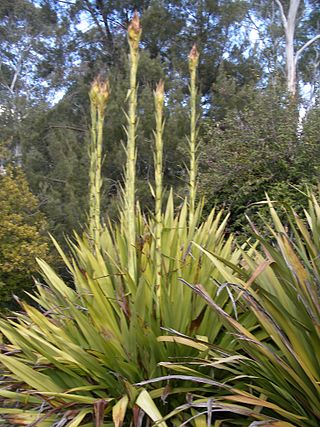
Doryanthes is the sole genus in the flowering plant family Doryanthaceae. The genus consists of two species, D. excelsa and D. palmeri, both endemic natives of the coast of Eastern Australia. Doryanthaceae is part of the order Asparagales.

The elm cultivar Ulmus 'Crispa' [:'curled', the leaf margin], sometimes known as the Fernleaf Elm, arose before 1800 and was first listed by Willdenow as U. crispa (1809). Audibert listed an U. campestrisLinn. 'Crispa', orme à feuilles crépues [:'frizzy-leaved elm'], in 1817, and an Ulmus urticaefolia [:'nettle-leaved elm'] in 1832; the latter is usually taken to be a synonym. Loudon considered the tree a variety of U. montana (1838). In the 19th century, Ulmus × hollandica cultivars, as well as those of Wych Elm, were often grouped under Ulmus montana. Elwes and Henry (1913) listed 'Crispa' as a form of wych elm, but made no mention of the non-wych samara.
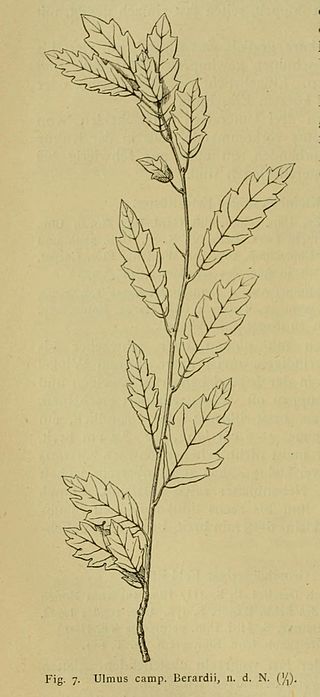
The elm cultivar Ulmus 'Berardii', Berard's Elm, was raised in 1865, as Ulmus Berardi, from seeds collected from large specimens of "common elm" growing on the ramparts at Metz, by an employee of the Simon-Louis nursery named Bérard. Carrière (1887), the Späth nursery of Berlin and the Van Houtte nursery of Gentbrugge regarded it as form of a Field Elm, listing it as U. campestris Berardii, the name used by Henry. Cheal's nursery of Crawley distributed it as Ulmus nitens [:Ulmus minor] 'Berardii'. Smith's of Worcester preferred the original, non-specific name, Ulmus 'Berardii'.

Plumbago auriculata, the Cape leadwort, blue plumbago or Cape plumbago, is a species of flowering plant in the family Plumbaginaceae, native to South Africa and Mozambique.

Hemerocallis lilioasphodelus is a plant of the genus Hemerocallis. It is found in China, northeastern Italy, and Slovenia. It was also one of the first daylilies used for breeding new daylily cultivars.

Calceolaria uniflora is a perennial plant of the genus Calceolaria, known as the slipperworts. It is originally from Tierra del Fuego in the southern part of South America.

Fritillaria persica is a Middle Eastern species of flowering plant in the lily family Liliaceae, native to southern Turkey, Iran, Iraq, Lebanon, Syria, Cyprus and Israel. It is widely cultivated as an ornamental and naturalized in the Lazio region of Italy. It is the sole species in Fritillaria subgenus Theresia.
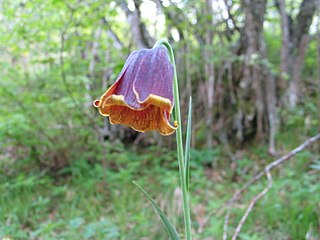
Fritillaria pyrenaica is a species of flowering plant in the lily family Liliaceae, native to the Pyrenees in Spain and France. Common names include Pyrenean fritillary and Pyrenean snake's-head. It is a bulbous perennial growing to 45 cm (18 in). The pendent, bell-shaped flowers are borne in spring. They have recurved tepals which are purple tinged with brown and yellow. Like other species in this genus, notably F. meleagris, they are strongly chequered.

Fritillaria pallidiflora is an Asian species of bulbous flowering plant in the lily family Liliaceae, native to Xinjiang, Kyrgyzstan and Kazakhstan. The common name frequently used is Siberian fritillary, a misnomer because the species does not grow in the wild in Siberia.

Coleonema is a genus of flowering plants in the family Rutaceae. The eight known species are all from the western Cape Province of South Africa. In Australia, where they are cultivated as garden ornamentals, they are often referred to as Diosma, a different genus in the same family.
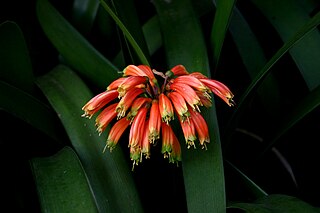
Clivia nobilis, the green-tip forest lily, is a species of flowering plant in the genus Clivia, of the family Amaryllidaceae, native to South Africa. It grows to about 38 cm (15 in). It has evergreen strap-shaped leaves, and bears pendent umbels of multiple narrow, trumpet-shaped, red and yellow flowers, tipped with green.
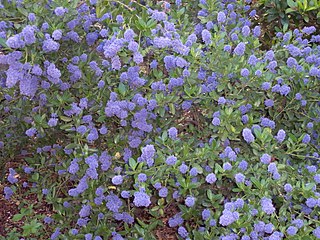
Ceanothus thyrsiflorus, known as blueblossom or blue blossom ceanothus, is an evergreen shrub in the buckthorn family Rhamnaceae that is endemic to Oregon and California in the US. The term 'Californian lilac' is also applied to this and other varieties of ceanothus, though it is not closely related to Syringa, the true lilac.

Gypsophila repens, the alpine gypsophila or creeping baby's breath, is a species of flowering plant in the family Caryophyllaceae, native to the mountains of central and southern Europe, where it grows on dry, chalky slopes. The Latin name literally means "creeping chalk-lover". It is a prostrate, mat-forming herbaceous perennial, growing around 20 cm (8 in) tall by 30–50 cm (12–20 in) wide. For much of the summer it bears masses of star-shaped flowers which may be white, lilac or light purple, in loose panicles.

Rosa'KORbin' is a white floribunda rose cultivar bred by Kordes in Germany in 1958. It is also known as Iceberg, Fée des Neiges and Schneewittchen. 'KORbin' is among the world's best known roses.

Argyranthemum frutescens, known as Paris daisy, marguerite or marguerite daisy, is a perennial plant known for its flowers. It is native to the Canary Islands. Hybrids derived from this species are widely cultivated as ornamental plants in private gardens and public parks in many countries, and have naturalized in Italy and southern California. There are many cultivars, but the most common has white petals.

Prostanthera cuneata, commonly known as alpine mint bush, is a species of flowering plant in the mint family Lamiaceae, and is endemic to mountainous areas of south-eastern continental Australia. It is an erect, compact shrub with egg-shaped leaves with the narrower end towards the base, and pale lavender to almost white flowers with purple blotches.

The Botanical Garden of Brussels is a former botanical garden in Brussels, Belgium. It was created in 1826 and stood on the Rue Royale/Koningsstraat in Saint-Josse-ten-Noode, near Brussels' Northern Quarter financial district, until its relocation in 1938 to the National Botanic Garden of Belgium in Meise, Flemish Brabant.

L'École Nationale Supérieure d'Horticulture was a French grande école of horticulture.
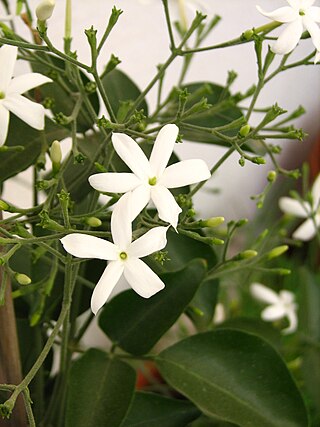
Jasminum azoricum, the lemon-scented jasmine, is a species of flowering plant in the olive family. It is an evergreen twining vine native to the Portuguese island of Madeira. The compound leaves consist of 3 bright green leaflets. The fragrant white star-shaped flowers appear in panicles from the leaf axils in summer, evolving from deep pink buds.
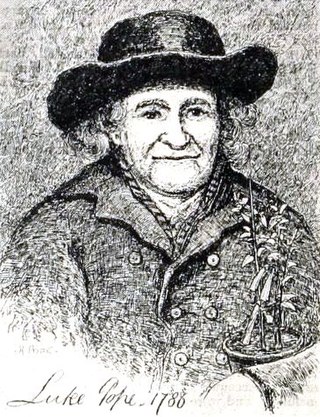
Luke Pope (1740–1825) was an English nurseryman and florist in the English West Midlands, who founded the firm that became John Pope & Sons. He was associated with the Manor of Smethwick, from whom he rented land and for whom he carried out the duties of constable and bailiff, and had nurseries there and in nearby Handsworth. He specialised in tulips, claiming on his deathbed to have spent more than £3,000 on them, and later in the shrubs and plants of North America for which his son John's travels in the United States were a source. His grandson, Luke Linnaeus Pope, prepared illustrations of plants from his father's stock as they would appear when they were in bloom.




















